Maybe this happens to you too. It starts with a list of Things To Do pinging around your brain. Perhaps your list is something like this: go buy diesel injector cleaner, take out the garbage, book flights home for Christmas, go for a run, replace the starter battery, go to Lord Mayor’s Show, properly dispose of contaminated diesel fuel, write blog about your weekend, book a flu shot, just please for the love of God get off the damned couch, etc. Or perhaps you don’t live in London and also pretend to regularly write a blog and also qualify for free NHS flu jab and also own an aged narrowboat with an exceedingly temperamental diesel engine. Nevertheless, whatever is on your list, sometimes deciding what to do is a bit paralysing. You start one thing, but then bounce off that and towards something else that you can’t concentrate on, and then on to a third thing you don’t finish, then back to the first thing, and eventually it all just feels stuck.
While your list may not be the same as mine, I suspect you'll still understand how I felt one Saturday not long ago, when the sky was sort of clear but my brain was definitely not. Luckily, Piran plucked me out of the mire with a short phonecall and reminded me of something I knew already, but needed to be told again: Doing something is almost always better than doing nothing. So I got off the couch (one thing done already!) and got properly dressed and headed to the City for The Lord Mayor’s Show.
So… there’s quite a bit to explain here. Astute Go Stay Work Play Live Readers have certainly already internalised the concept of the City of London so I won’t beat that dead horse again. However, we haven’t yet covered the Lord Mayor of London yet, let alone his show, so settle in.
The Lord Mayor of the City of London is, naturally, the mayor of the City of London and also the head of the City of London Corporation (the municipal governing body of the City). The Lord Mayor of London has nothing to do with the directly elected Mayor of the Greater London Authority. Clear as mud? Good. Within the City, the Lord Mayor is accorded precedence over everyone other than the Queen and in modern times their role is about supporting and promoting local residents and businesses - especially the financial sector - by delivering lots of speeches, hosting visiting dignitaries, being driven around in a Rolls Royce Phantom, and looking good in ermine and tights.
The Lord Mayor of London is elected yearly on Michelmas, and in November the new Lord Mayor is sworn in. One of the ancient requirements of the office dates back to the reign of King John in 1215, when the King granted the City the right to elect its own mayor. (Prior to that the mayor had been appointed by the sovereign.) (Yes, prior to 1215. This is not a recent phenomenon.)
"Know ye that we have granted … to our barons of our city of London, that they may choose to themselves every year a mayor, who to us may be faithful, discreet and fit for government of the city, so as, when he shall be chosen, to be presented unto us, or our Justice if we shall not be present… and he shall swear to be faithful to us…” (from the 1215 London Charter)
Astute Go Stay Work Play Live Readers will note that this charter requires the Lord Mayor to be presented to the sovereign or his Justice and swear fealty, a requirement still observed today. In medieval times, this meant the newly minted Mayor sailed up the Thames from the City to the seat of royal power at Westminster. That trip gradually attracted more and more hangers on and eventually grew into a festive terrestrially-based parade now known as The Lord Mayor’s Show!
So the Lord Mayor’s Show is a parade! And who doesn’t love a parade?
Fun Fact: The term “float” used for parade vehicles originated with the decorated barges that made up the Lord Mayor’s procession along the Thames.
Actually, it’s not just one parade but two. First, the entire menagerie travels from Guildhall - the ceremonial and administrative centre of the City of London Corporation - to the Lord Mayor’s official residence at Mansion House and then to the the Royal Courts of Justice on the Strand. Whereupon everyone in the parade hangs about on the street for a bit while the new Lord Mayor swears an oath of allegiance to the Queens Bench. Following that, everything starts back up again for the triumphal return to Mansion House.
This is where I came in, because my busy morning of dithering meant I didn’t arrive on scene until the procession was already at the Royal Courts. The parade is now so extensive that it’s actually longer than the distance between Guildhall and the Royal Courts and has to budge up into side streets between the Strand and the river before the return journey.
This meant that when I finally arrived, I was the one parading past the muddled floats, lounging marching bands, the odd tank surrounded by soldiers drinking cups of tea, and a lot of signs like the one on this excellent vintage horse-drawn double decker bus:
Livery companies started life as medieval guilds and have evolved into modern trade organisations for various crafts, fields, and professions. Many show their medieval roots in their names, such as the Mercers (general merchants), Fishmongers, Haberdashers and Goldsmiths. Livery companies are normally styled as The Worshipful Company of Pewterers or, to cite a more modern addition, The Worshipful Company of Management Consultants (which really does not have the same ring). The term “livery" originally referred to the specific dress or uniform worn by the household servants of noblemen and by extension came to mean any special dress denoting a particular status or trade.
There are currently 110 livery companies registered by the city of London, including the mellifluously named Worshipful Society of Apothecaries and the less romantic Worshipful Company of Tax Advisers. The list of livery companies is maintained in a strict order of precedence established in 1515 (when there were only 48), and is based on their economic power at that time. The remaining 62 companies are ranked according to seniority, which explains why the Launderers outrank the International Bankers. Go Launderers!
Bonus Fun Fact*: The Worshipful Company of Merchant Taylors and the Worshipful Company of Skinners have long disputed their ranking in the order of precendence, so each year at Easter they swap places between six and seven on the list. This is thought to be the origin of the phrase “at sixes and sevens”. (*Note: not guaranteed to be a fact)
Extra Bonus Fun Fact**: Membership in a livery company conveys upon the liveryman the Freedom of the City of London. Now largely a formality, it once conveyed other privileges, including the right to drive sheep across London Bridge, as demonstrated by Stephen Fry in this diverting 45 minute dive into the City. (**Note: Actual fact!)
One of the other privileges of liverymen is the election of the Lord Mayor of London. Each year, the members of the City’s livery companies come together for the election in Common Hall, which is not a physical location but rather the name given to a gathering of liverymen. The physical location of the Common Hall is Guildhall, which is all appropriately medieval-sounding, given the Lord Mayor of London occupies one of the world's oldest continuously elected civic offices.
Back at the parade route, I was getting a bit peckish and decided to find a nice cafe to sit down, warm up, and possibly get a start on the blog while waiting for the parade to get going again. Sadly, even through the Lord Mayor’s Show attracts thousands of people to the area, very few of the local places were open. This is quite common in the City, which is utterly dependent on the 500,000 people who work there during the week (pre-COVID), as opposed to the mere 9,000 who actually live within the City’s boundary. On weekends the City is normally quite deserted and most shops, pubs and restaurants don’t bother opening up.
St. Bride’s is also known for its association with journalism and the printing trade, which is no surprise given its location just off Fleet Street. And the church enjoys a close relationship with the Worshipful Company of Stationers and Newspaper Makers. The City is like that - it’s just utterly packed with history and connections that fold back on themselves over and over. This is true all over England, but in the City it’s concentrated to an almost ludicrous degree. This is evidenced by the amount of time it took me to write this post. I normally spend a fair bit of time clicking around semi-purposefully soaking in information about whatever is the topic at hand. For this post that process was notably longer because there is just so much to soak in.
Anyway, St. Bride’s was open and, more importantly for me that day, they were serving tea and coffee and had a tempting array of packaged treats so I made a donation and settled into a seat in the quire to relax for a bit. By this point AGSWPLRs will note that we’re now 1,700 words in and there’s still no parade in sight. What can I say? It was that kind of day. But fear not, I finally made it out of St. Bride's and onto the parade route where I stood outside Blackfriar’s Station waiting for what seemed like ages. Luckily, there were Morris Dancers, so that was as bafflingly diverting as Morris Dancing always is.
And, finally, finally, the parade could be heard approaching, led by the Band of The Grenadier Guards and the Band of The Coldstream Guards.
And then it was really was a proper parade.
And finally, after the fancy dress and the soldiers and the liverymen (soooooo many liverymen) the man of the hour appeared.

And then it was over, except for the cleaning up. As with any parade that includes livestock, street-cleaning is a necessary part of the aftermath. But because it's London, even that comes with a footnote. The phrase "after the Lord Mayor’s Show, comes the dust cart" has long meant a disappointing or mundane event occurring straight after an exciting or magnificent one. As in, "We were expecting a great game after last week's barn-burner, but it was all a bit after the Lord Mayor's Show." Which accorded perfectly with the next item on my agenda that Saturday: a trip to the Marble Arch Mound. The Marble Arch Mound was very, very after the Lord Mayor's Show.
And eventually I booked flights for Christmas, and got my flu jab, and, obviously, I wrote a blog.
Don't ask about the boat.



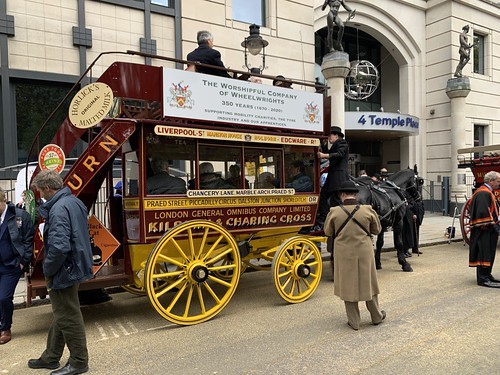
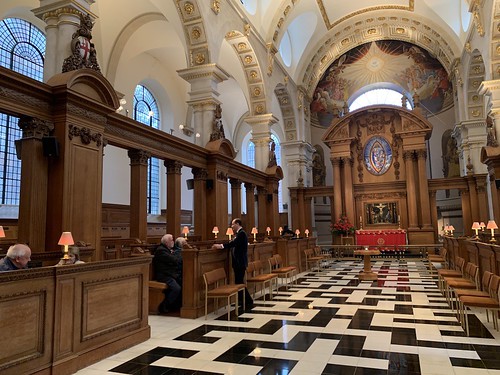
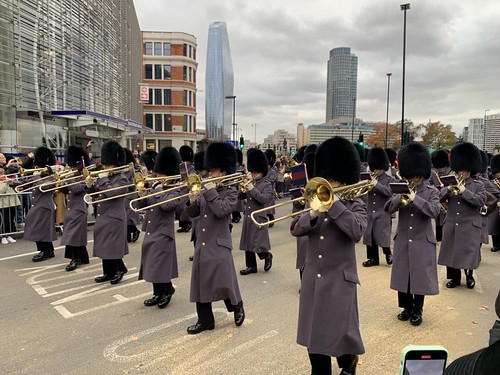

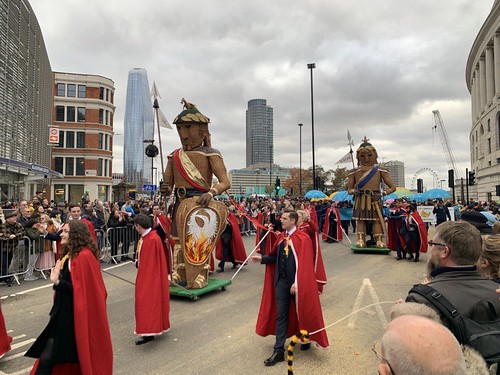

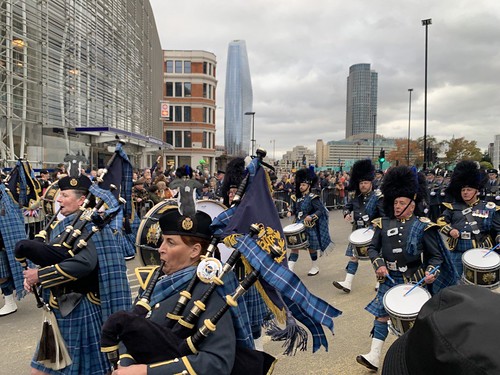




2 Comments:
I especially love finding out the origins of things we say but never try to explain. 6's and 7's will never be the same. Glad you persevered until the actual parade actually began AND to learn that flights are booked. -S.
Love the sixes and seven's origin - true or not. Also loved the Steven Fry video.
Post a Comment